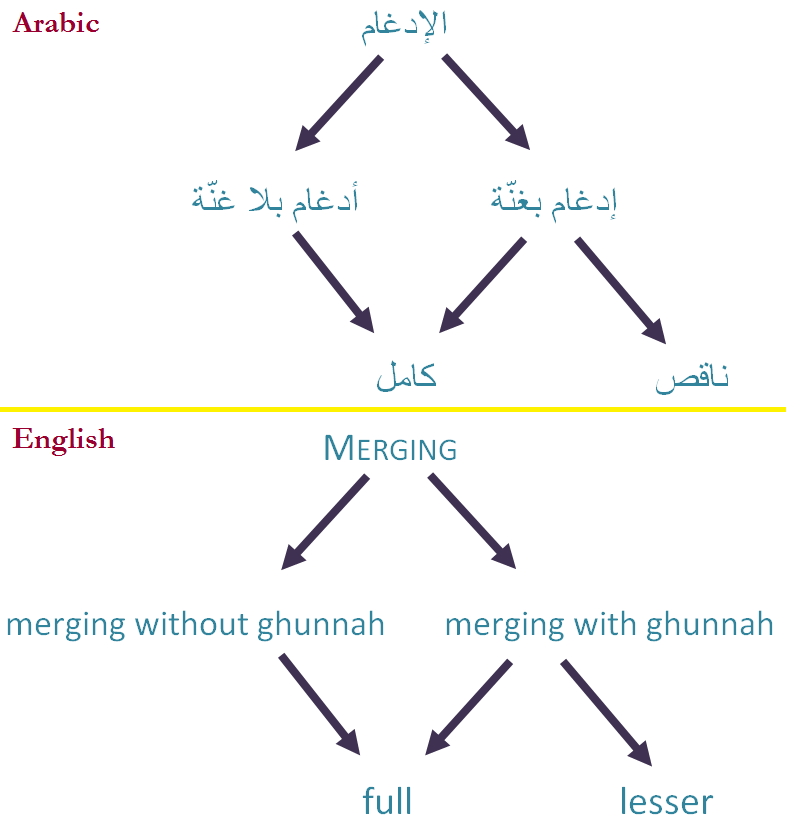Merging things together can be heaps of fun. I tend to enjoy combining colours together to create new, fascinating ones. The fourth rule for Al-Noon Al-Saakinah is all about merging/combining. This rule is said to be one of the most complicated rules. But there is nothing to fret about because practice makes perfect, insha Allah.
Rule four: Al-Idghaam — Al-Idkhaal (To merge with)
There are two types of Idghaam. and from these two, a couple more branch out. Take a look at the diagram below:
Let’s start with what ghunnah means.
Ghunnah: A ghunnah is the sound made entirely by the nose [this is in regards to the sounds coming from the mouth].
An Idghaam bi ghunnah occurs with any Tanween or Noon Saakinah if it is followed by any of these letters:
ي ن م و
waw meem noon yaa
This completes the first level of the diagram when following the rightmost arrow.
Merging without ghunnah, i.e. Idghaam bila ghunnah occurs when the letters
ل ر
raa laam
follow a Noon Saakinah or Tanween. Now the leftmost arrow of the first level of the diagram is complete. [i.e. the entire first level is now complete].
With these two letters, raa and laam, their idghaam is called: idghaam bila ghunnah kaamel, or in English, merging without ghunnah fully.
Here the “nn” sound from the Tanween or Noon Saakinah is completely eliminated and the laam or raa are said straight away without any emphasis on their sounds. Hence why the “fully” is added onto the end – i.e. noting that the “nn” sound is “fully” wiped out.
Examples of idghaam bila ghunnah kaamel / merging without ghunnah fully:
وَيْلٌ لِكُلِّ هُمَزَةٍ لُمَزَةٍ
waylun likulli humazatin lumazah
The two “n” I have in red are completely eliminated and so the verse is read as,
waylulikulli humazatilumaza
Notice the two green letters are now the place where the two words are connected without the Tanween. Some students [and I know quite a few] have trouble in the beginning trying to connect two words without the “nn” sound in between. They end up “leaning on” the laam or raa and saying them as though there is a shaddah[1] on these two letters. However there isn’t.
But here you may protest that in fact there is. Look at the example above. There is a shaddah on the laam in both cases for the words likulli and lumazah. This shaddah is not there for shaddah purposes. It has been put there as a notice to the reader that the Tanween (or Noon Saakinah) is not to be pronounced at all, not even through the nasal passage.
Below is a second example using a Noon Saakinah.
مِنْ رَبِّ
min rabbi read as, mir-rabbi
While I still have your attention [I hope], and avoiding any confusion possible, insha Allah, I’ll continue on with the rightmost arrow, merging with ghunnah.
Recall that a ghunnah is a sound made entirely by the nose [nasalisation], somewhere between a hum and a moan. Like an aeroplane engine, probably. The merging with ghunnah letters as above have two categories. “Full” and “lesser”. Full idghaam means that this aeroplane humming comes through sounding a lot stronger than it would when the lesser one is made. The letters,
ن م
meem noon
coincide with a full idgham bi ghunnah, where as the remaining letters,
ي و
waw yaa
are to be said with a “lesser idgham bi ghunnah“. Idgham bi ghunnah, whether fuller or lesser is sounded for two counts, similar to the time it takes to say the words, “one – two”.
Examples of a full idghaam bi ghunnah:
مِنْ مَرْقَدِنَا رَسُولٌ مِنْ
rasoolun min min marqadinaa
مِنْ مَارِجٍ مِنْ نَارٍ
min maarijen min naaren
(3 occurrences of a fuller idghaam bi ghunnah)
note: min maarij – maarijen min – min naar
Examples of lesser idghaam bi ghunnah:
ضَلَالَةٌ وَلَكِنِّي
dalaalatun walaakinni
مِنْ يَوْمِهِمُ
min yawmihem
Examples of idghaam bila ghunnah kaamel:
بِدِينَارٍ لَا
bideenaaren la
فَوَيْلٌ لِلَّذِينَ
fawaylun lillatheena
Notice here the shaddah on the first laam is to note the ruling of idghaam bila ghunnah kaamel. The second shaddah however is there for shaddah purposes. You are to “double” the sound of the second laam so it is said as I’ve written above, lil-latheena.
Idghaam is something I find very beautiful. It’s adds a tremendous tone to recitation and I think it, alongside the rule regarding noon and meem mushadadah, adds a very serene and tranquil sensation for the both listener and reader.
What’s that rule I just mentioned? Keep an eye out for new posts.
Resources Link:
–Shaddah [Tajweed Basics: Foundations and More: page 2]
[Gatway To Arabic: page 49]
–Idghaam [Tajweed Basics: Foundations and More: page 12]
–Tanween [Gatway To Arabic: pages 40-43]
–Sukoon [Gatway To Arabic: page 48]
[1] – Shaddah: is to double the sound of a letter so that it is stressed. Such a letter is said to be mushaddad.





